From the 11th International Shibori Symposium in Japan to Metamorfizm Magdalena Abakanowicz in Poland, these international summer exhibitions are not to be missed:
11th International Shibori Symposium Nagoya, Japan
The 11th International Shibori Symposium will take place throughout June and July in three separate, yet connected regions of Japan: Tokyo, Nagoya, Yonezawa and Yamagata. The symposium will explore the regions shared legacies of craft and local industry revolving around Safflower, Indigo and Shibori. In addition to workshops and demonstrations, the symposium specially organized ten exhibitions chronicling the history and future of shibori. browngrotta arts artist Carolina Yrarrázaval’s work has been selected to be a part of International Contemporary Art of Shibori at the Tama Art University Museum in Tokyo (July 1 – August 19). This year’s topics of discussion include local industry, technology and tradition, global trade and material transformation. “Local industries create foundations for the community and environment which we build textile practices,” explains the World Shibori Network by “emphasizing sustainability, regional history and people and their skills, we showcase the enduring legacy of artisans and craftspeople who support traditions and inspire future generations.” For more information on the 11th International Shibori Symposium click HERE.
Jane Balsgaard: SKIBET OG BØLGEN at Kunsthuset Palæfløjen.
In Denmark, Jane Balsgaard has a new solo exhibition at Kunsthuset Palæfløjen. The exhibition’s theme revolves around the ship as an artifact with free interpretation of ships, the sea and waves. SKIBET OG BØLGEN highlights Balsgaard’s unique technique and impeccable craftsmanship. Balsgaard’s use of natural materials, such as handmade paper and found objects has made her a pioneer in the Danish Art Scene. In addition to displaying many of Balsgaard’s pieces, there is also a documentary by Torben Glarbo, in which you can see the production Silent Flight, Balsgaards installation in the Manchester Airport.SKIBET OG BØLGEN will run through June 24th, for more information on this exhibition click HERE.
Jun Tomita at Johanniterkirche in Feldkirch, Austria (September 14th, 2018 – Sometime in December depending on temperature)
Feldkirch, Austria will be the site of a one-person exhibition of ikat works by Jun Tomita in Japan. For more information of Johanniterkirche and Feldkirch click HERE.
Tim Johnson’s Lines and Fragments at Korbmacher-Museum Dalhausen
In Germany, the Korbacher-Museum Dalhausen will be hosting Tim Johnson’s solo exhibition Lines and Fragments. Johnson, who uses a variety of plant materials from his adopted home of Catalonia, combines the specific characteristics of the plant materials with different weaving techniques, both traditional and experimental, in order create endless possibilities for creativity and expression. Line and Fragments will display Johnson’s recent work, while also exploring his 20 years of braiding research. “As a basketmaker working today I look towards combining tradition and experimentation to lead me into new areas. Looking at traditional woven objects in museums and collections we find only part of the story of the making and are left to imagine the life of the object ourselves,” explains Johnson. “The rightness of design and signs of usage in old traditional baskets fascinate me and I hope to capture some of their magic in my own makings. While I’m neither a fisherman nor a farmer and my baskets are not functional, perhaps my work celebrates our woven cultural inheritance whilst creating something that has not existed before.” In the past, the museum has hosted strong exhibitions of traditional basketry work from Spain, Uganda and France. Johnson’s exhibition will be the first contemporary show the museum has ever done. Lines and Fragments will be on display at the Korbacher-Museum Dalhausen from July 15th until September 9th, after which it will travel to Lichtenfels in southern Germany. For more information on Lines and Fragments click HERE.
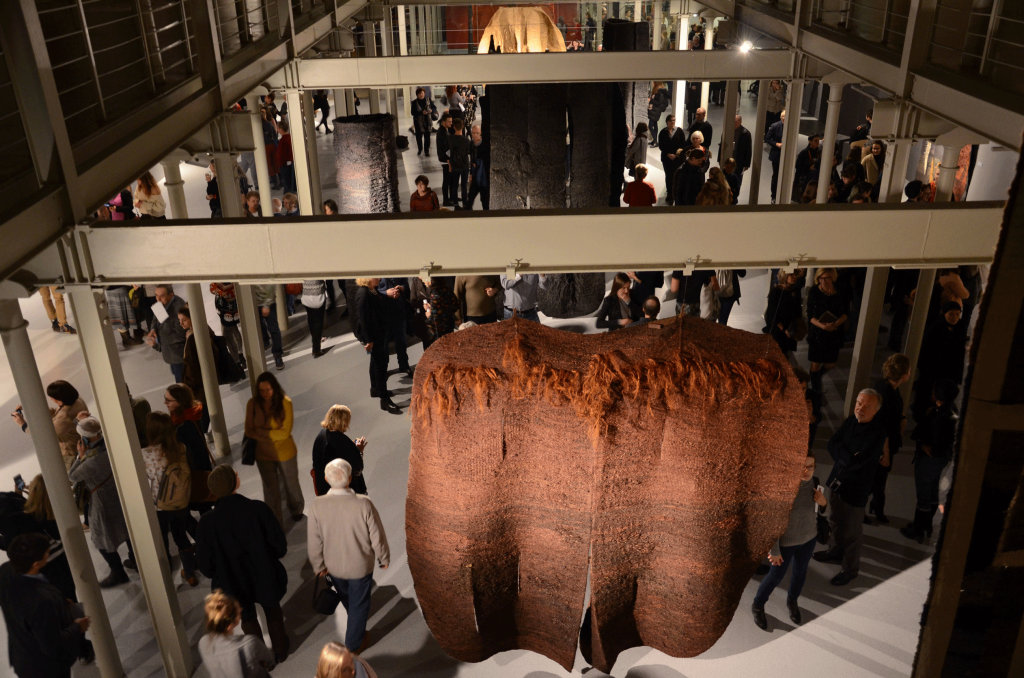
Metamorfizm Magdalena Abakanowicz at The Central Museum of Textiles in Łódź, Poland. Photo: The Central Museum of Textiles
Metamorfizm. Magdalena Abakanowicz (1930 – 2017) in Łódź, Poland
In Łódź, Poland, The Central Museum of Textiles and the Swiss Toms Pauli Foundation opened a collaborative exhibition to pay tribute to Magdalena Abakanowicz. Metamorfizm Magdalena Abakanowicz, which is set to run from May 17th through September 9th, seeks to shed a light on how Abakanowicz revolutionized the field of textile art. Abakanowicz’s international career started in Lausanne at the city’s first Tapestry Biennial in 1962. The exhibition has about thirty pieces of Abakanowicz’s work, ranging from mural creations, sculptures in relief and unusual collages. All of which celebrate the diversity and modernity of Abakanowicz’s artistic experimentation from 1965 to 1985. In addition to Abakanowicz’s work, there will be a screening of Kazimierz Mucha’s movie, accompanied by music composed by Bogusław Schäffer. Mucha’s movie footage examines Abakanowicz’s 1968 open-air art installation in Łeb. The installation’s organic material ’Abakans’ “surrender to the gusts of wind, move and integrate into the surrounding landscape of the wild dunes, accentuating their biological provenance.” Metamorfizm not only spotlights Abakanowicz’s work but also calls attention to the intellectual sources of Abakanowicz’s work. For more information on Metamorfizm click HERE.




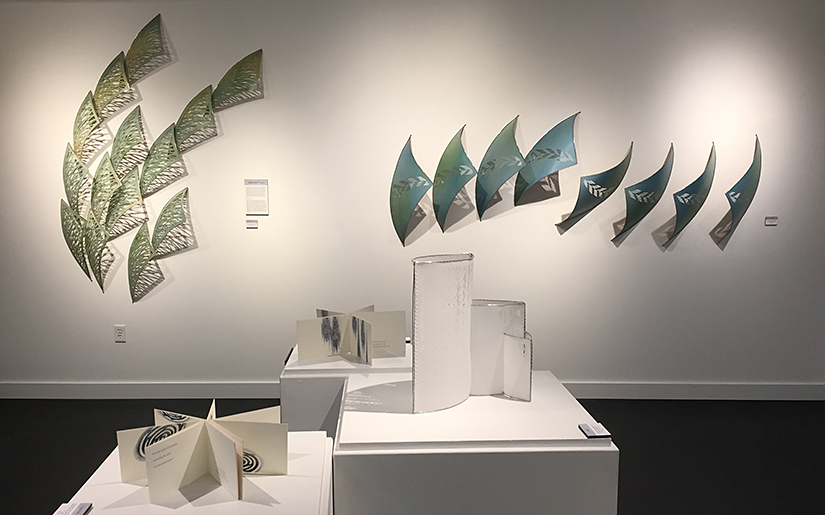

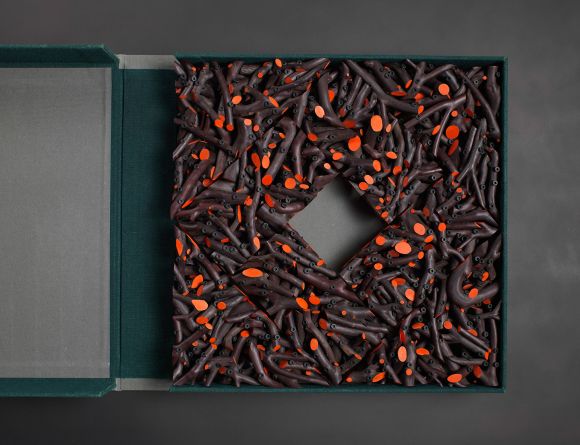
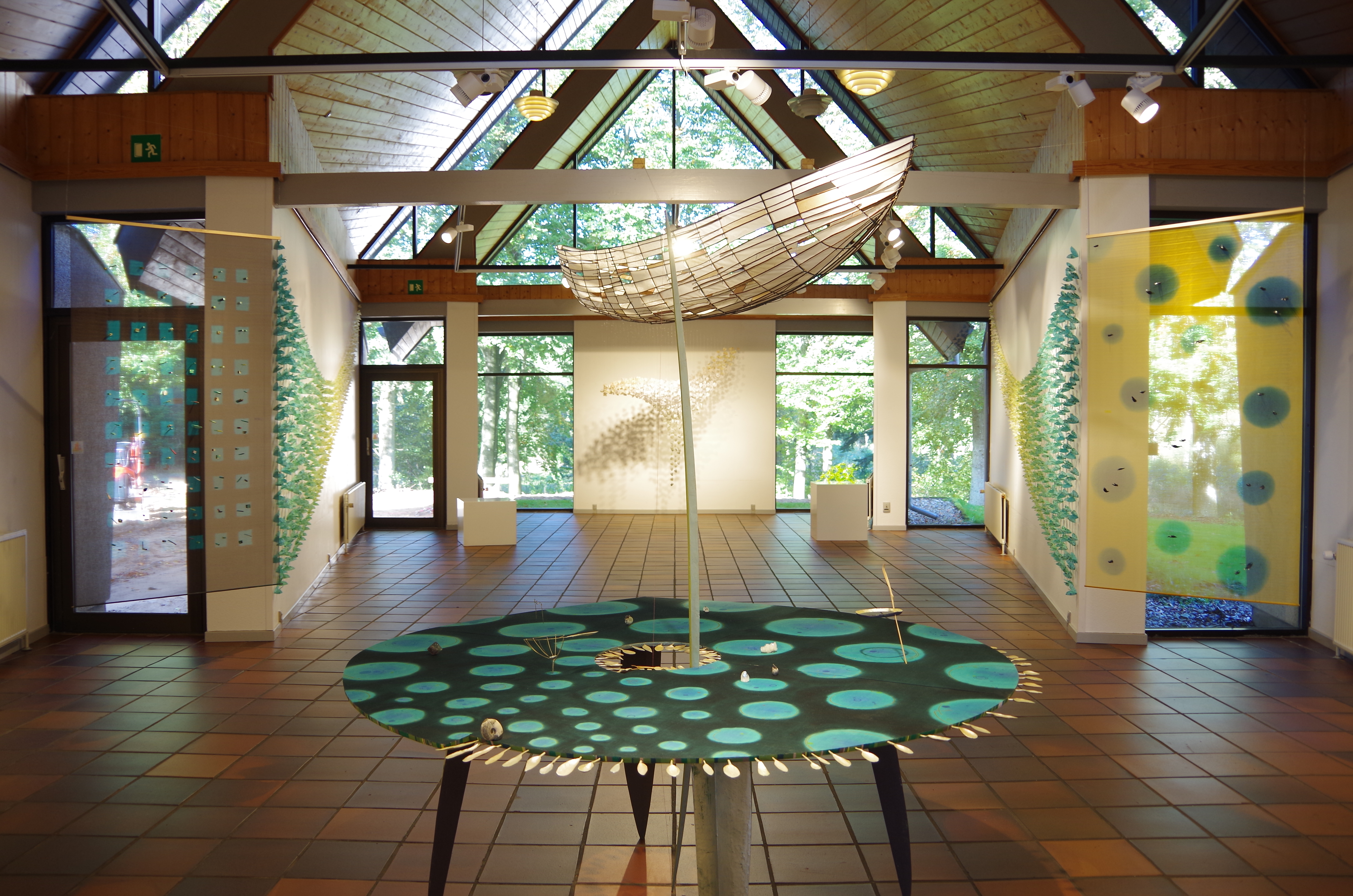
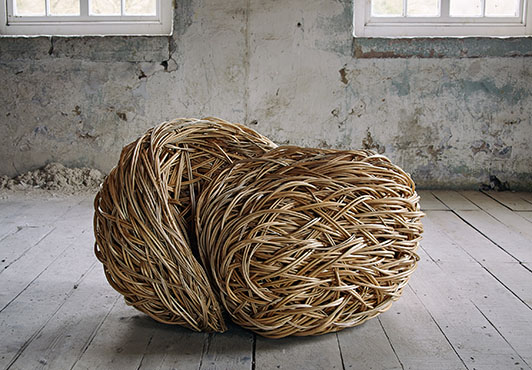


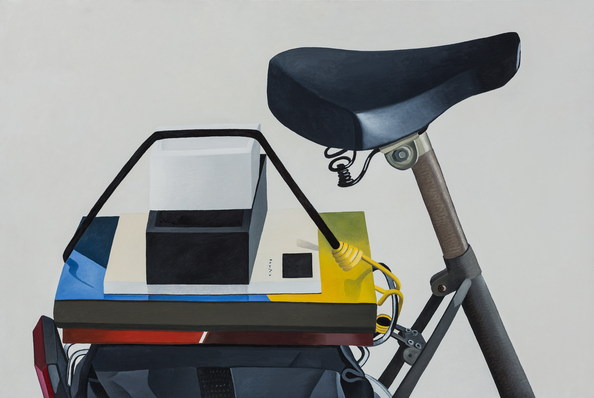
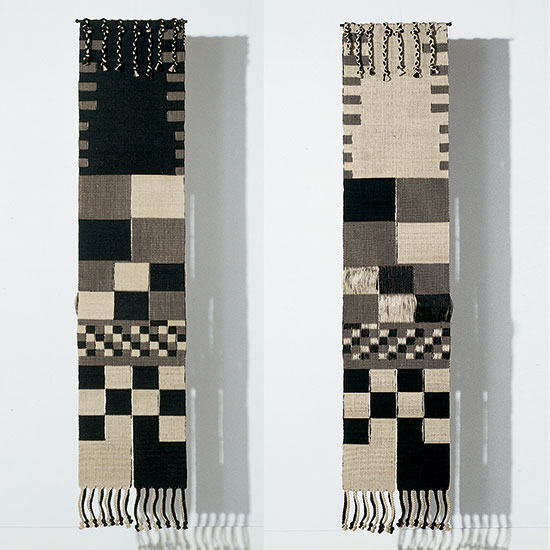


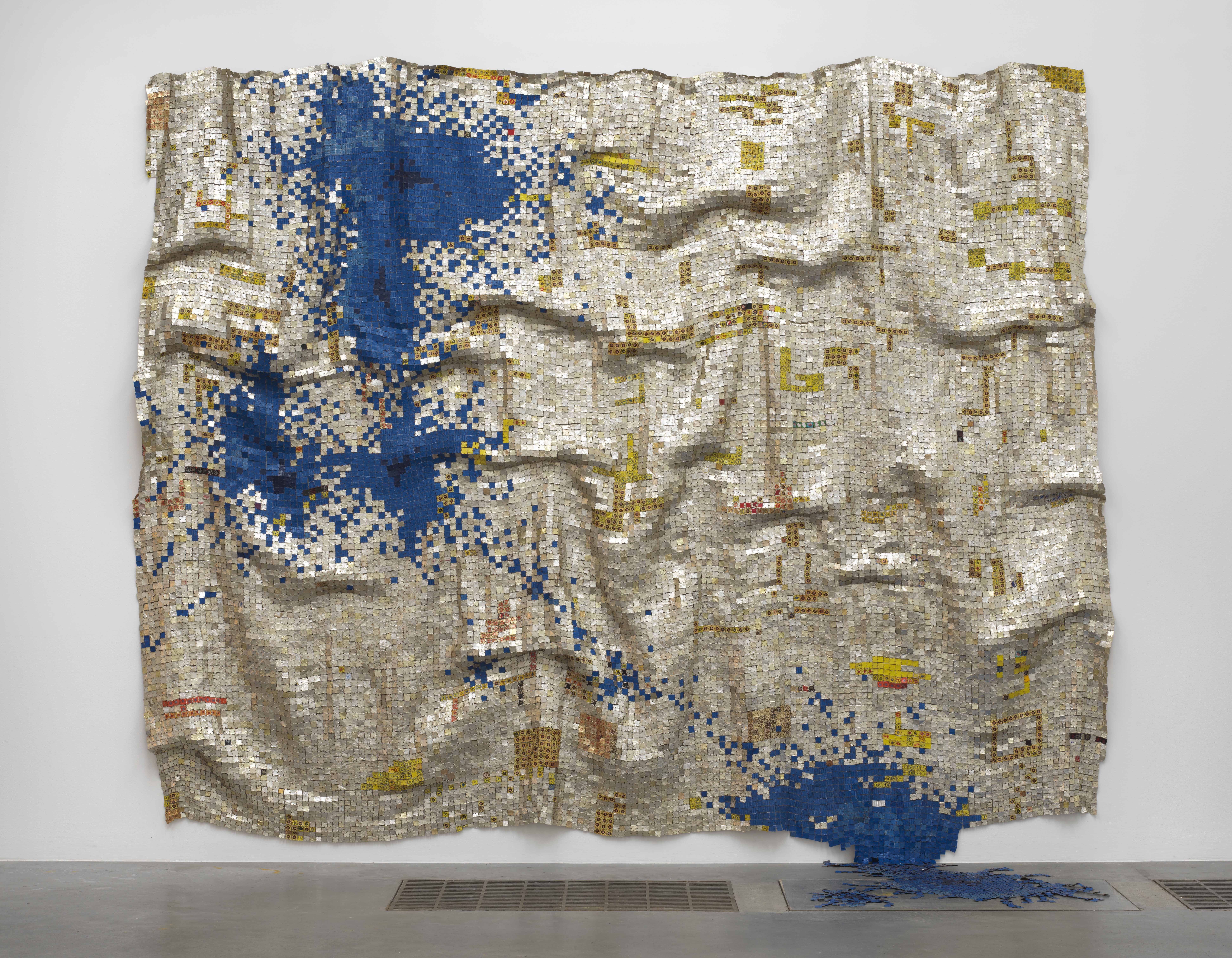
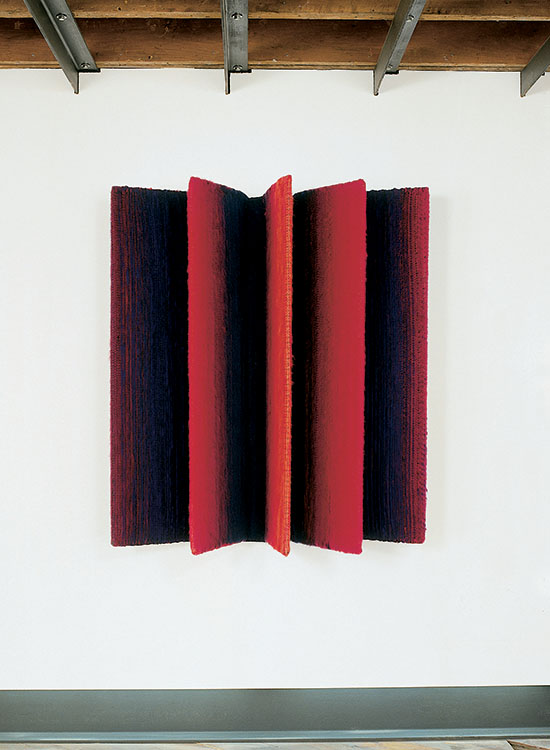
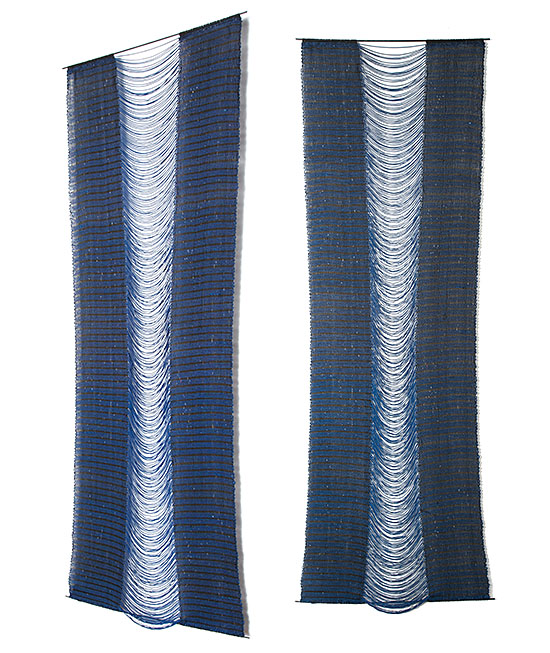

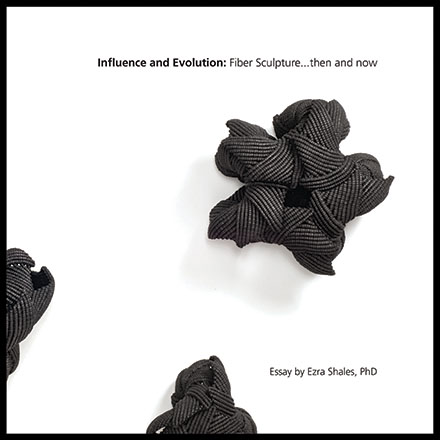

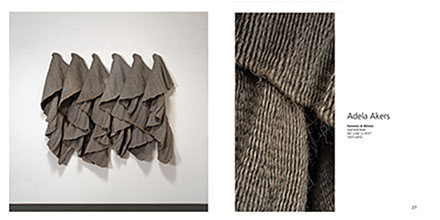
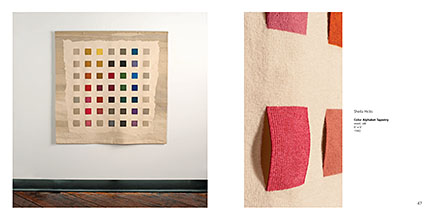
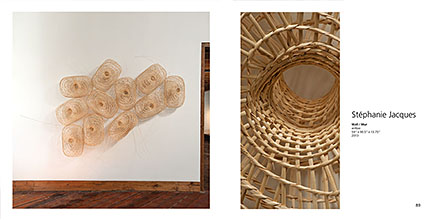

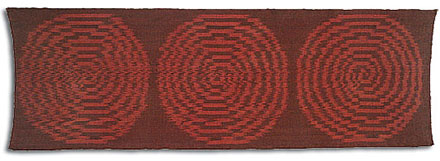
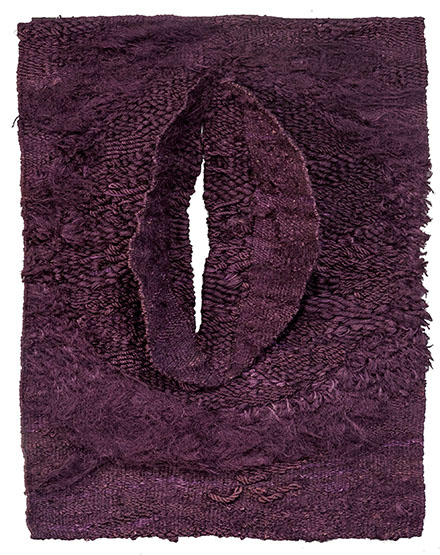
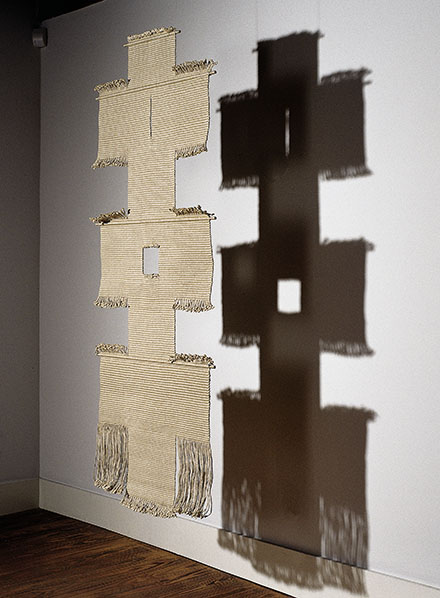

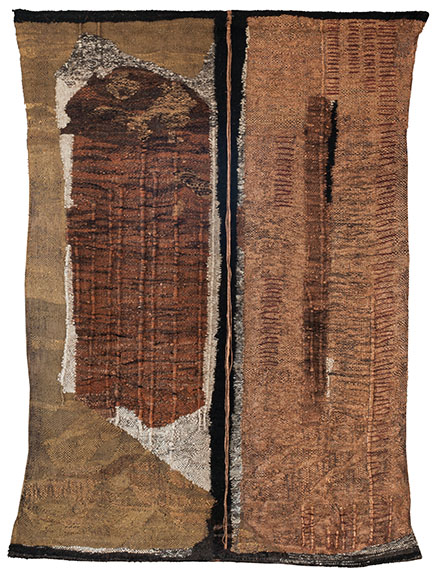


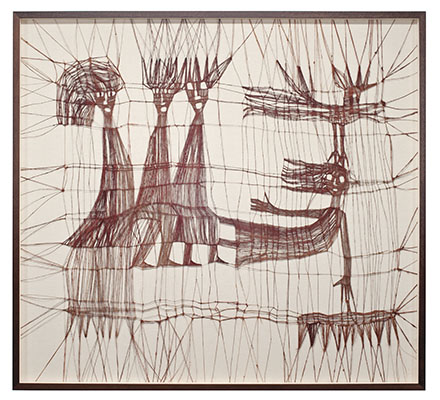

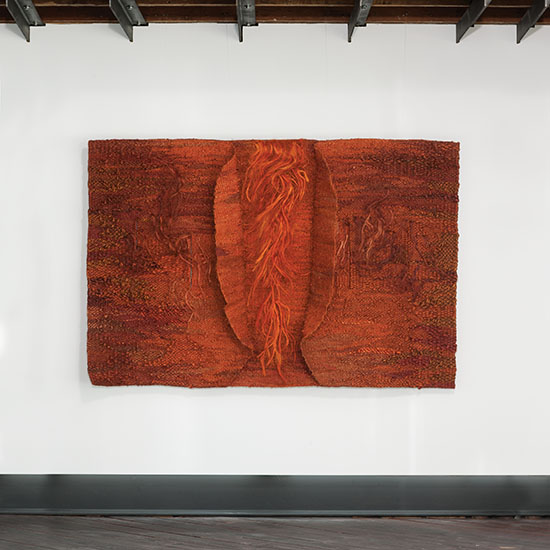

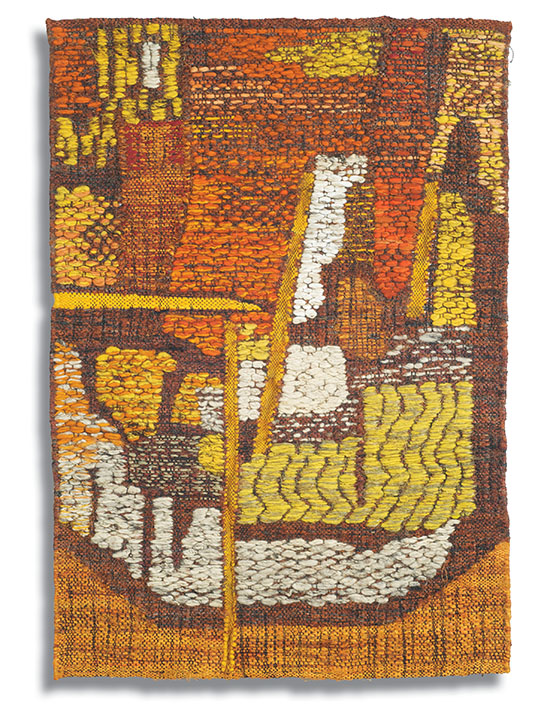
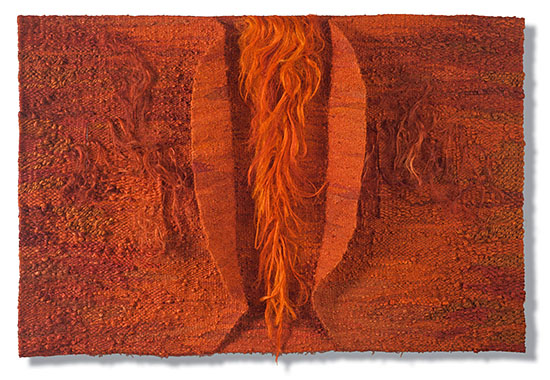
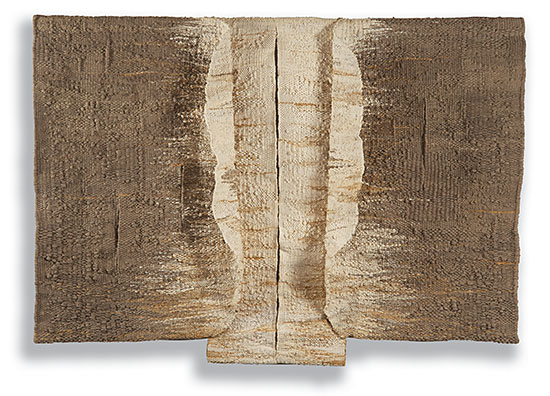
The Resurgence of Interest in Fiber Sculpture and Art Textiles Will Continue in 2015
Last year was an extraordinary one for those of us who appreciate contemporary art fiber and art textiles. More than 10 exhibitions opened in the US and abroad. In October, the art newspaper reported that “textiles are gaining international stature in art museums” and further that “[c]ommercial interest is on the rise,” quoting art advisor Emily Tsingou: “Textile [art] has entered the mainstream.” Soft Fabrics-Have Solid Appeal. Below is a roundup of exhibitions and reviews from last year and a guide to what to expect in 2015.
Mainstream attention began with the coverage of Sheila Hicks‘ inclusion
Sheila Hicks, Pillar of Inquiry/Supple Column, 2013-14 (installation view, Whitney Museum of American Art, New York). Photograph by Bill Orcutt
in the Whitney Biennial in March and was followed by coverage of the restoration of her remarkable 1960s tapestries at the Ford Foundation in New York Sheila Hicks Tapestries to Again Hang at Ford Foundation. In June, the Art Institute of Chicago’s textile galleries reopened, featuring 96-year-old Ethel Stein’s work, in Ethel Stein, Master Weaver.
September saw three fiber-related exhibitions; the Museum of Arts and Design opened What Would Mrs. Webb Do? A Founder’s Vision (closes
February 8, 2015),Kay Sekimachi, Ed Rossbach, Françoise Grossen, Katherine Westphal and others Museum of Art Design installation of What Would Mrs Webb Do?, Photo by Tom grotta
February 8, 2015), which featured significant textiles from the permanent collection by Anni Albers, Kay Sekimachi, Katherine Westphal, Ed Rossbach, Françoise Grossen and Trude Guermonprez, while The Drawing Center’s: Thread-Lines offered Anne Wilson creating fiber art in situ
Ann Wilson’s In Situ Performance at the Drawing Center, photo by Tom Grotta
together with a collection of works by Lenore Tawney, Louise Bourgeois and others. Contemporary 108 in Tulsa, Oklahoma, featured a series of large photographic weavings by Aleksandra Stoyanov of the Ukraine
Contemporary 108 in Tulsa, Oklahoma, curated from the 2013 “Aleksandra Stoyanov” Tefen Open Museum, Israel exhibition. photo copyright Tefen Open Museum
and now Israel, described as “warp and weft paintings.”
In October, Fiber: Sculpture 1960 – present, opened at the Institute of Contemporary Art in Boston with works by 34 artists including
Fiber: Sculpture 1960 — present opening, photo by Tom Grotta
Magdalena Abakanowicz, Ritzi Jacobi and Naomi Kobayashi. The Boston Globe called the exhibition “[s]plendid, viscerally engaging…groundbreaking;” the exhibition catalog (available at browngrotta.com) was pronounced by Blouin art info, “an amazing resource for anyone interested in learning more about the medium.” Art Info – Art in the Air Fiber Sculpture 1960 Present October also saw a survey of the work of sculptor and poet, Richard Tuttle, at the Tate in London, Richard Tuttle:
I Don’t Know, Or The Weave of Textile Language in which Tuttle investigated the importance of textiles throughout history, across his remarkable body of work and into the latest developments in his practice. Tate Modern – Richard Tuttle I Don’t Know or Weave Textile Language
Throughout the year, Innovators and Legends, with work by 50 fiber
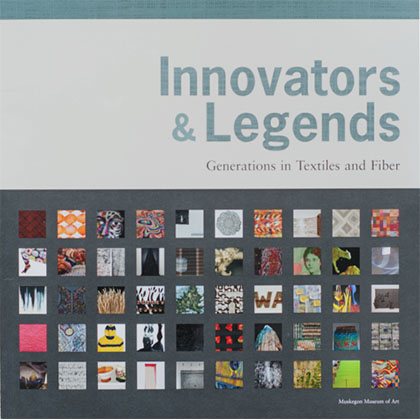
artists, including Adela Akers, Nick Cave, Katherine Westphal and Sherri Smith toured the US, exhibiting at museums in Colorado, Iowa and Kentucky. The fiber fanfest culminated at Art Basel in Miami Beach in December, where Blouin’s Art Info identified a full complement of fiber works and textiles in its listing, “Definitive Top 11 Booths, “ including Alexandra da Cunha’s compositions of mass-produced beach towels and various colored fabrics at Thomas Dane Gallery, a Rosemarie Trockel embroidered work at Galerie 1900-2000, marble and dyed-fabric pieces by Sam Moyer at Galerie Rodolphe Janssen and woven paintings by Brent Wadden at Mitchell-Innes & Nash Blouin Art info – The Definitive Top-11 Booths at Art Basel Miami Beach.
And what’s ahead in 2015?
More auctions and exhibitions that include fiber sculpture and art textiles are scheduled for 2015. Fiber: Sculpture 1960 – present will
open at the Wexner Center for the Arts, Columbus, Ohio on February 7th and travel to the Des Moines Art Center, Iowa in May.
Sonia Delaunay Prismes electriques 1914 Centre Pompidou Collection, Mnam / Cci, Paris © Pracusa 2013057
dedicated her life to experimenting with color and abstraction, bringing her ideas off the canvas and into the world through tapestry, textiles, mosaic and fashion.
Also in April, the Museum of Arts and Design will host Pathmakers:
Lenore Tawney in her Coenties Slip studio, New York, 1958.
Courtesy of Lenore G. Tawney Foundation; Photo by David Attie
Women in Art, Craft and Design, Midcentury and Today, featuring work by Sheila Hicks, Lenore Tawney and Dorothy Liebes http://madmuseum.org/exhibition/pathmakers.
In June, the Toms Pauli Foundation in Lausanne, Switzerland will celebrate the International Tapestry Biennials held there from 1962 to 1995 and display work by the Polish textile artist and sculptor Magdalena Abakanowicz, in an exhibition entitled, Objective Station.
1995 and display work by the Polish textile artist and sculptor Magdalena Abakanowicz, in an exhibition entitled, Objective Station.
Also this summer, the Musée d’Art Contemporain de Baie St Paul in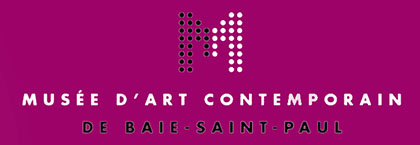
Mariette Rousseau Vermette Portrait by Tom Grotta
Quebec, Canada will examine the work of Mariette Rousseau-Vermette, who participated in five of the Lausanne Biennials.
From April 24 – May 3, 2015, browngrotta arts will host Influence and Evolution, Fiber Sculpture then and now at our barn/home/gallery space in Wilton, Connecticut. In its 27-year history, browngrotta arts
Françoise Grossen, From the Mermaid Series IV, 1983, photo by Tom Grotta
including Magdalena Abakanowicz, Lia Cook, Kay Sekimachi and Françoise Grossen, with works from a later generation of artists, all born after 1960, through whom fiber sculpture continues to evolve. These artists, including María Eugenia Dávila and Eduardo Portillo of Venezuela, Stéphanie Jacques of Belgium and Naoko Serino of Japan, work in a time when classification of medium and material presents less of a constraint and fiber and fiber techniques can be more readily explored for their expressive potential alone.
“It is rare to find so many inventive, compelling works in one show, and it astounds that many are so little known,” wrote Kirsten Swenson in Art in America, about Fiber: Sculpture 1960 – present, in October 2014. Art in America Magazine – reviews: Fiber Sculpture 1960-present. This spring, in Influence and Evolution, browngrotta arts will offer dozens more significant works of fiber art for collectors to appreciate and new audiences to discover — more than two dozen works by fiber pioneers and another 30 more recent fiber explorations. We hope you will visit the exhibition, order the catalog or both. Please contact us for more information about what’s in store. art@browngrotta.com